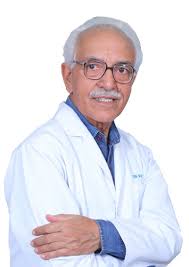What is Unilateral Total Knee Replacement?
Unilateral Total Knee Replacement (UTKR), also known as single knee replacement, is a surgical procedure that involves replacing the surfaces of only one knee joint—either the left or the right—with a prosthetic implant. The surgery is indicated when the knee's articular cartilage is severely damaged due to osteoarthritis, rheumatoid arthritis, post-traumatic arthritis, or joint deformities.
Unlike bilateral replacement, which addresses both knees in a single or staged procedure, UTKR is performed on patients who have symptoms confined to only one knee. It involves removing the worn-out cartilage and bone and replacing them with metal and plastic components to restore alignment, movement, and function.
Who is a Candidate for Unilateral Total Knee Replacement?
A patient may be considered a good candidate for unilateral total knee replacement if:
- They experience chronic pain in one knee that limits daily activities like walking or climbing stairs.
- The pain persists despite non-surgical treatments such as medications, injections, and physical therapy.
- Imaging (X-ray or MRI) confirms severe damage in one knee while the other remains relatively healthy.
- The patient is generally in good health and capable of undergoing anesthesia and rehabilitation.
UTKR is also suitable for younger, more active patients who want to preserve as much of their natural anatomy and function as possible while reducing pain and disability.
What Are the Different Types and Approaches to Unilateral Knee Replacement?
There are several approaches to performing unilateral total knee replacement, based on the surgical technique and implant type used:
Types of Implants:
- Fixed-bearing implants: Most commonly used; offer stability and durability.
- Mobile-bearing implants: Allow slight movement for better flexibility.
- Posterior-stabilized implants: Best for patients with weakened ligaments.
- Gender-specific implants: Designed to match anatomical differences in male and female knees.
Surgical Approaches:
- Traditional Approach: A standard 8–12 inch incision is made; suitable for most patients.
- Minimally Invasive Surgery (MIS): Uses a smaller incision (4–6 inches), leading to faster recovery.
- Computer-Assisted Surgery (CAS): Uses 3D mapping for precision in implant placement.
- Robotic-Assisted Surgery: Improves alignment and accuracy, often resulting in quicker rehab.
Each approach is tailored to the patient’s age, bone condition, physical activity level, and overall health.
What Is the Step-by-Step Treatment Protocol for UTKR?
The treatment protocol for unilateral total knee replacement in India is comprehensive and patient-centered. It includes the following stages:
1. Pre-Operative Evaluation:
- Medical history and physical exam
- X-rays, MRI, and blood tests
- Cardiac evaluation and anesthetic assessment
- Consultation with orthopedic and physiotherapy teams
2. Pre-Surgery Preparation:
- Patient education and counseling
- Prehabilitation exercises to strengthen muscles
- Fasting and medication review 12–24 hours prior
3. Surgical Procedure:
- Administered under spinal or general anesthesia
- Incision made over the knee; damaged cartilage is removed
- Implants inserted and aligned to restore joint mechanics
- Incision is closed and dressing applied
- Duration: approx. 1.5 to 2 hours
4. Immediate Post-Operative Care:
- Pain management and infection prevention
- Start passive movement exercises within 24 hours
- Begin physiotherapy under supervision
5. Discharge and Recovery Plan:
- Hospital stay: typically 3–5 days
- Home physiotherapy continues for 4–6 weeks
- Most patients regain independent mobility within 6–8 weeks
This evidence-based protocol ensures minimal complications and optimal functional outcomes.
What Types of Implants and Materials Are Used in Unilateral Knee Replacement?
In unilateral total knee replacement, the choice of implant is critical for ensuring stability, durability, and natural joint function. Several internationally approved materials and designs are used to match each patient's anatomy and activity level.
Types of Implants:
- Fixed-Bearing Implants: The most common and cost-effective option, designed for long-term use in less active patients.
- Mobile-Bearing Implants: Offer greater flexibility and rotation; ideal for younger, more active individuals.
- Posterior-Stabilized Implants: Used when knee ligaments are weak or damaged.
- Cruciate-Retaining Implants: Allow preservation of the posterior cruciate ligament (PCL) for more natural movement.
Materials Used:
- Cobalt-Chromium Alloys: Highly durable and corrosion-resistant.
- Titanium and Titanium Alloys: Lightweight and biocompatible.
- Polyethylene: Medical-grade plastic used in the spacer component.
- Ceramic Coatings: Less common but offer high wear resistance.
All implants used in India are FDA- and CE-approved, ensuring safety and long-term performance for international patients.
What Is the Cost Breakdown of Unilateral Knee Replacement in India?
India offers one of the most cost-efficient and transparent healthcare systems for orthopedic surgeries. Below is a realistic cost breakdown for international patients undergoing unilateral total knee replacement:
|
Cost Component |
Approximate Cost (USD) |
|
Initial Consultation & Diagnostics |
$100 – $200 |
|
Blood Tests, ECG, Chest X-ray |
$50 – $100 |
|
MRI or Advanced Imaging |
$100 – $250 |
|
Surgeon’s Fees |
$800 – $1,200 |
|
Anesthesia and OT Charges |
$400 – $600 |
|
Implant Cost (depending on brand) |
$1,000 – $2,000 |
|
Hospital Stay (3–5 days) |
$500 – $800 |
|
Medications & Consumables |
$200 – $300 |
|
Physiotherapy and Rehabilitation |
$200 – $400 |
|
Post-Operative Review and Reports |
$100 – $200 |
Total Estimated Cost in India: $4,000 to $5,500
Note: The final cost may vary slightly depending on the city, hospital category, implant brand, and room type (private/semi-private).
Why Do International Patients Choose India for This Surgery?
India is a global leader in orthopedic medical tourism, attracting thousands of patients annually. Reasons include:
World-Class Infrastructure:
- JCI and NABH-accredited hospitals with cutting-edge technology.
Experienced Orthopedic Surgeons:
- Many are internationally trained with high surgical volumes and expertise.
Significantly Lower Costs:
- Save up to 80–90% on medical bills compared to the West.
Zero Wait Times:
- Quicker surgery scheduling, even for complex cases.
Seamless Language & Culture Fit:
- English-speaking staff, multilingual support teams, and international patient departments.
These factors make India the preferred destination for high-quality, affordable, and timely knee replacement surgery.
Why Choose Healzone for Your Knee Replacement and Medical Travel?
Healzone specializes in coordinating seamless and stress-free medical travel for international patients. Here’s why patients choose Healzone:
End-to-End Coordination:
- Airport pick-up, visa assistance, hotel bookings, and hospital appointments—all managed under one roof.
Partner Network of Accredited Hospitals:
- Only JCI/NABH-certified hospitals with top-tier orthopedic surgeons are included.
Multilingual Patient Support:
- Dedicated international case managers for pre- and post-treatment coordination.
Transparent Pricing:
- No hidden charges; complete cost breakdown shared upfront.
Post-Surgery Virtual Support:
- Online follow-ups, medication reviews, and rehab consultation from your home country.
Choosing Healzone ensures that your medical journey in India is safe, smooth, and cost-effective, backed by care, compassion, and clinical excellence.
What Are the Surgical Techniques and Anesthesia Used in Unilateral Knee Replacement?
Unilateral total knee replacement surgery is typically performed using standardized and globally accepted surgical techniques, tailored to the patient’s condition and surgeon’s expertise.
Surgical Techniques:
- Traditional Approach: Involves an 8–10 inch incision over the knee to expose the joint. Most widely practiced.
- Minimally Invasive Surgery (MIS): Uses smaller incisions (4–6 inches), resulting in less muscle damage and quicker recovery.
- Computer-Assisted Surgery (CAS): Aids in precise alignment and implant positioning using 3D imaging.
- Robotic-Assisted Surgery: Enhances precision through robotic arms, used in advanced orthopedic centers.
Anesthesia Options:
- Spinal Anesthesia (Preferred): Numbs the lower half of the body and allows quicker post-op mobility.
- General Anesthesia: Induces complete unconsciousness; used based on patient preference or medical condition.
- Regional Nerve Blocks: Often used alongside spinal or general anesthesia to manage post-surgical pain.
The procedure usually takes 1.5 to 2 hours, and patients are moved to recovery for observation immediately after surgery.
What Is the Recovery and Rehabilitation Process After Surgery?
Recovery from unilateral total knee replacement follows a well-defined, phased protocol to ensure the best possible outcomes.
Hospital Recovery (Days 1–5):
- Mobilization typically begins within 24 hours post-op.
- Pain is managed with oral and IV medications.
- Physiotherapy includes ankle pumps, leg raises, and walker-assisted walking.
Early Home Recovery (Weeks 2–6):
- Progressive weight-bearing with or without a walker.
- Stair climbing and knee bending exercises introduced gradually.
- Wound healing monitored; stitches removed after 10–14 days.
Mid-Term Recovery (Weeks 6–12):
- Improved range of motion and strength.
- Resumption of driving and office work (if job is sedentary).
- Discontinuation of walking aids.
Full Recovery (3–6 Months):
- Return to moderate physical activity, travel, and hobbies.
- Independent and pain-free mobility achieved.
Compliance with physiotherapy is the key factor in achieving complete joint function post-surgery.
What Are the Risks and How Are They Managed?
While unilateral knee replacement is a safe and highly successful procedure, as with any major surgery, there are some associated risks. These can be minimized through expert care and proper aftercare.
Common Risks:
- Infection: Localized or deep joint infections; minimized with antibiotics and sterile technique.
- Blood Clots: DVT or pulmonary embolism risk; managed with blood thinners and early mobility.
- Pain and Swelling: Temporary and managed with medications and physiotherapy.
Less Common Risks:
- Implant Loosening: May require revision surgery if it occurs years later.
- Nerve Damage: Rare, usually temporary if it occurs.
- Limited Range of Motion: Often due to poor rehab compliance.
Risk management involves:
- Pre-operative optimization of patient health
- Use of infection control protocols
- Immediate postoperative mobilization
- Regular follow-ups and rehab tracking
How Long Do Implants Last and What Is the Long-Term Care Plan?
Modern knee implants used in unilateral total knee replacement are designed for long-term performance, often lasting decades when properly cared for.
Implant Lifespan:
- 15 to 20 years for standard implants
- Up to 25 years with advanced materials and precise alignment
Long-Term Care Guidelines:
- Maintain a healthy body weight to reduce stress on the implant.
- Engage in low-impact activities like swimming, walking, and cycling.
- Avoid high-impact sports such as running or jumping.
- Schedule annual orthopedic reviews with X-rays to monitor implant integrity.
- Follow prescribed exercises to keep surrounding muscles strong and supportive.
With a balanced lifestyle and regular care, most patients experience decades of pain-free mobility and improved quality of life.
What Are the Key Benefits of Unilateral Total Knee Replacement?
Unilateral total knee replacement offers a targeted solution for patients suffering from severe pain in one knee while keeping the other knee untouched. The benefits are both functional and lifestyle-enhancing.
Major Advantages:
- Pain Relief: Eliminates chronic knee pain and inflammation.
- Improved Mobility: Enables walking, climbing stairs, and other daily activities.
- Targeted Approach: Only the affected knee is replaced, preserving natural movement in the healthy joint.
- Shorter Surgery Time: Lower anesthesia and hospital risks than bilateral replacement.
- Faster Recovery: Less physical burden during rehab.
- Cost-Effective: More affordable than replacing both knees simultaneously.
The procedure significantly improves the patient’s independence, confidence, and overall quality of life.
How Should International Patients Prepare for Unilateral Knee Replacement in India?
International patients considering knee replacement in India should follow a structured plan to ensure a smooth and successful medical journey.
Before Traveling:
- Medical Records: Gather recent X-rays, MRIs, prescriptions, and medical history documents.
- Consult Your Local Physician: Get a medical fitness certificate for travel and surgery.
- Visa Application: Apply for a Medical Visa (M-Visa) to India; Healzone will provide an official invitation letter if required.
- Travel Insurance: Consider purchasing a policy that covers medical travel (optional but recommended).
What to Pack:
- Comfortable clothing and walking shoes
- Personal medications and medical documents
- Supportive braces or mobility aids if used
- Passport, visa, and payment documents
Planning in advance ensures a hassle-free arrival, timely consultations, and stress-free recovery.
What Medical Tourism Support Services Are Provided in India?
Healzone and its partner facilities offer comprehensive international patient services, making India one of the easiest countries for medical travel.
Services Include:
- Personalized case coordination before and after arrival
- Assistance with medical visa and travel planning
- Airport pick-up and drop-off
- Hotel/hospital accommodation booking
- Language translation (if needed)
- Dedicated international patient department for 24/7 assistance
- Help with currency exchange and local SIM cards
- Help with tourism activities post-recovery (optional)
This all-inclusive support system ensures that international patients are not only well cared for medically, but also culturally and logistically.
What Post-Surgical Support Do International Patients Receive?
After surgery, patients require structured support to achieve optimal recovery. Healzone ensures this support is available throughout the patient’s stay and even after their return home.
In India:
- Daily physiotherapy sessions at the hospital or rehab facility
- Progress monitoring by the orthopedic team
- Post-discharge medication, wound care instructions, and follow-up appointments
Post-Departure:
- Digital copies of all medical records and imaging
- Virtual follow-up consultations with your surgeon
- Guidance for continued physiotherapy in your home country
- Prescription support for any required medications
This end-to-end recovery model ensures safe healing and minimizes the need for readmission.
What Lifestyle Changes Should Patients Make After Surgery?
Long-term success after unilateral total knee replacement depends on maintaining a healthy lifestyle that protects the joint and supports mobility.
Recommended Changes:
- Adopt a low-impact fitness routine (walking, swimming, cycling)
- Maintain a healthy weight to reduce pressure on the implant
- Follow a balanced diet rich in calcium and Vitamin D
- Avoid smoking and excessive alcohol, which hinder healing
- Take prescribed medications as directed
- Attend routine checkups and maintain rehab consistency
These changes contribute to the implant’s longevity and the patient’s overall health







